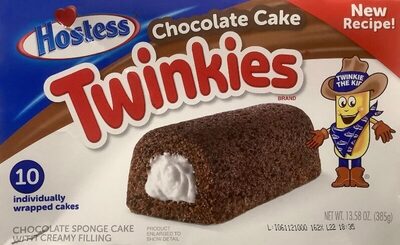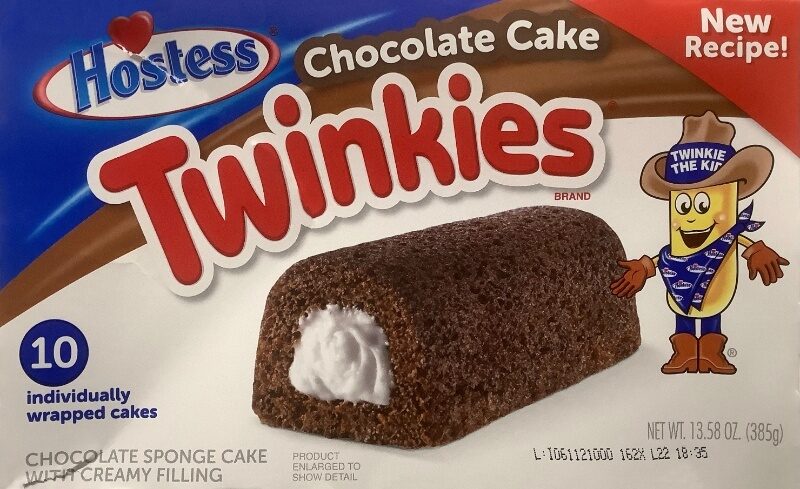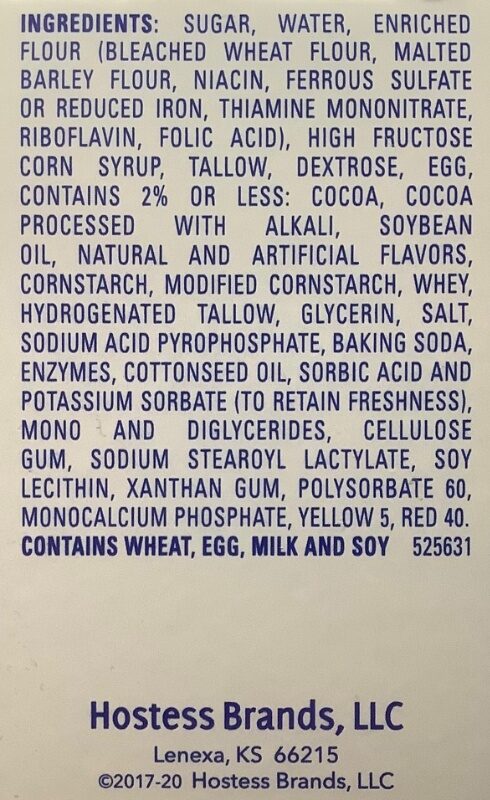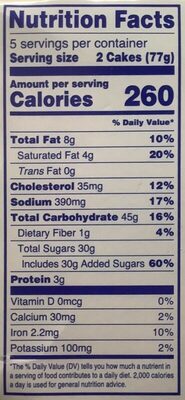Help us make food transparency the norm!
As a non-profit organization, we depend on your donations to continue informing consumers around the world about what they eat.
The food revolution starts with you!
Twinkies - Chocolate Cake - Hostess - 385g
Twinkies - Chocolate Cake - Hostess - 385g
This product page is not complete. You can help to complete it by editing it and adding more data from the photos we have, or by taking more photos using the app for Android or iPhone/iPad. Thank you!
×
Barcode: 0888109111854 (EAN / EAN-13) 888109111854 (UPC / UPC-A)
Quantity: 385g
Brands: Hostess, Hostess Brands
Brand owner: Hostess Brands, LLC
Categories: Snacks, Sweet snacks, Biscuits and cakes, Cakes, Chocolate cakes
Countries where sold: Germany, Saudi Arabia, United States
Matching with your preferences
Health
Ingredients
-
46 ingredients
Water, sugar, enriched flour (bleached wheat flour, malted barley flour, niacin, ferrous sulfate or reduced iron, thiamine mononitrate, riboflavin, folic acid), corn syrup, high fructose corn syrup, palm oil, tallow, cocoa processed with alkali, glycerin, contains 2% or less: modified cornstarch, soybean oil, egg white, egg, baking soda, corn starch, natural and artificial flavor, hydrogenated tallow, salt, defatted soy flour, dextrose, sorbic acid (to retain freshness), cellulose gum, cottonseed oil, mono and diglycerides, whey, calcium caseinate, sodium caseinate, soy protein isolate, guar gum, sodium aluminum phosphate, sodium acid pyrophosphate, monocalcium phosphate, fumaric acid, enzymes, polysorbate 60, soy lecithin.Allergens: Eggs, Gluten, Milk, Soybeans
Food processing
-
Ultra processed foods
Elements that indicate the product is in the 4 - Ultra processed food and drink products group:
- Additive: E322 - Lecithins
- Additive: E412 - Guar gum
- Additive: E422 - Glycerol
- Additive: E435 - Polyoxyethylene sorbitan monostearate
- Additive: E450 - Diphosphates
- Additive: E466 - Sodium carboxy methyl cellulose
- Additive: E471 - Mono- and diglycerides of fatty acids
- Ingredient: Dextrose
- Ingredient: Flavouring
- Ingredient: Glucose
- Ingredient: High fructose corn syrup
- Ingredient: Whey
Food products are classified into 4 groups according to their degree of processing:
- Unprocessed or minimally processed foods
- Processed culinary ingredients
- Processed foods
- Ultra processed foods
The determination of the group is based on the category of the product and on the ingredients it contains.
Additives
-
E200 - Sorbic acid
Sorbic acid: Sorbic acid, or 2‚4-hexadienoic acid, is a natural organic compound used as a food preservative. It has the chemical formula CH3-CH-4CO2H. It is a colourless solid that is slightly soluble in water and sublimes readily. It was first isolated from the unripe berries of the Sorbus aucuparia -rowan tree-, hence its name.Source: Wikipedia
-
E297 - Fumaric acid
Fumaric acid: Fumaric acid or trans-butenedioic acid is the chemical compound with the formula HO2CCH=CHCO2H. It is produced in eukaryotic organisms from succinate in complex 2 of the electron transport chain via the enzyme succinate dehydrogenase. It is one of two isomeric unsaturated dicarboxylic acids, the other being maleic acid. In fumaric acid the carboxylic acid groups are trans -E- and in maleic acid they are cis -Z-. Fumaric acid has a fruit-like taste. The salts and esters are known as fumarates. Fumarate can also refer to the C4H2O2−4 ion -in solution-.Source: Wikipedia
-
E322 - Lecithins
Lecithins are natural compounds commonly used in the food industry as emulsifiers and stabilizers.
Extracted from sources like soybeans and eggs, lecithins consist of phospholipids that enhance the mixing of oil and water, ensuring smooth textures in various products like chocolates, dressings, and baked goods.
They do not present any known health risks.
-
E322i - Lecithin
Lecithins are natural compounds commonly used in the food industry as emulsifiers and stabilizers.
Extracted from sources like soybeans and eggs, lecithins consist of phospholipids that enhance the mixing of oil and water, ensuring smooth textures in various products like chocolates, dressings, and baked goods.
They do not present any known health risks.
-
E341 - Calcium phosphates
Calcium phosphate: Calcium phosphate is a family of materials and minerals containing calcium ions -Ca2+- together with inorganic phosphate anions. Some so-called calcium phosphates contain oxide and hydroxide as well. They are white solids of nutritious value.Source: Wikipedia
-
E341i - Monocalcium phosphate
Calcium phosphate: Calcium phosphate is a family of materials and minerals containing calcium ions -Ca2+- together with inorganic phosphate anions. Some so-called calcium phosphates contain oxide and hydroxide as well. They are white solids of nutritious value.Source: Wikipedia
-
E412 - Guar gum
Guar gum (E412) is a natural food additive derived from guar beans.
This white, odorless powder is valued for its remarkable thickening and stabilizing properties, making it a common ingredient in various food products, including sauces, dressings, and ice creams.
When used in moderation, guar gum is considered safe for consumption, with no known adverse health effects.
-
E422 - Glycerol
Glycerol: Glycerol -; also called glycerine or glycerin; see spelling differences- is a simple polyol compound. It is a colorless, odorless, viscous liquid that is sweet-tasting and non-toxic. The glycerol backbone is found in all lipids known as triglycerides. It is widely used in the food industry as a sweetener and humectant and in pharmaceutical formulations. Glycerol has three hydroxyl groups that are responsible for its solubility in water and its hygroscopic nature.Source: Wikipedia
-
E450 - Diphosphates
Diphosphates (E450) are food additives often utilized to modify the texture of products, acting as leavening agents in baking and preventing the coagulation of canned food.
These salts can stabilize whipped cream and are also found in powdered products to maintain their flow properties. They are commonly present in baked goods, processed meats, and soft drinks.
Derived from phosphoric acid, they're part of our daily phosphate intake, which often surpasses recommended levels due to the prevalence of phosphates in processed foods and drinks.
Excessive phosphate consumption is linked to health issues, such as impaired kidney function and weakened bone health. Though diphosphates are generally regarded as safe when consumed within established acceptable daily intakes, it's imperative to monitor overall phosphate consumption to maintain optimal health.
-
E466 - Sodium carboxy methyl cellulose
Carboxymethyl cellulose: Carboxymethyl cellulose -CMC- or cellulose gum or tylose powder is a cellulose derivative with carboxymethyl groups --CH2-COOH- bound to some of the hydroxyl groups of the glucopyranose monomers that make up the cellulose backbone. It is often used as its sodium salt, sodium carboxymethyl cellulose.Source: Wikipedia
-
E471 - Mono- and diglycerides of fatty acids
Mono- and diglycerides of fatty acids (E471), are food additives commonly used as emulsifiers in various processed foods.
These compounds consist of glycerol molecules linked to one or two fatty acid chains, which help stabilize and blend water and oil-based ingredients. E471 enhances the texture and shelf life of products like margarine, baked goods, and ice cream, ensuring a smooth and consistent texture.
It is generally considered safe for consumption within established regulatory limits.
-
E500 - Sodium carbonates
Sodium carbonates (E500) are compounds commonly used in food preparation as leavening agents, helping baked goods rise by releasing carbon dioxide when they interact with acids.
Often found in baking soda, they regulate the pH of food, preventing it from becoming too acidic or too alkaline. In the culinary world, sodium carbonates can also enhance the texture and structure of foods, such as noodles, by modifying the gluten network.
Generally recognized as safe, sodium carbonates are non-toxic when consumed in typical amounts found in food.
-
E500ii - Sodium hydrogen carbonate
Sodium hydrogen carbonate, also known as E500ii, is a food additive commonly used as a leavening agent.
When added to recipes, it releases carbon dioxide gas upon exposure to heat or acids, causing dough to rise and resulting in a light, fluffy texture in baked goods.
It is generally recognized as safe (GRAS) by regulatory authorities when used in appropriate quantities and poses no significant health risks when consumed in typical food applications.
-
E541 - Sodium aluminium phosphate
Sodium aluminium phosphate: Sodium aluminium phosphate -SAlP- describes the inorganic compounds consisting of sodium salts of aluminium phosphates. The most common SAlP has the formulas NaH14Al3-PO4-8·4H2O and Na3H15Al2-PO4-8. These materials are prepared by combining alumina, phosphoric acid, and sodium hydroxide.In addition to the usual hydrate, an anhydrous SAlP is also known, Na3H15Al2-PO4-8 -CAS#10279-59-1-, referred to as 8:2:3, reflecting the ratio of phosphate to aluminium to sodium. Additionally an SAlP of ill-defined stoichiometry is used -NaxAly-PO4-z -CAS# 7785-88-8-.The acidic sodium aluminium phosphates are used as acids for baking powders for the chemical leavening of baked goods. Upon heating, SAlP combines with the baking soda to give carbon dioxide. Most of its action occurs at baking temperatures, rather than when the dough or batter is mixed at room temperature. SAlPs are advantageous because they impart a neutral flavor. As a food additive, it has the E number E541. Basic sodium aluminium phosphates are also known, e.g., Na15Al3-PO4-8. These species are useful in cheese making.Source: Wikipedia
Ingredients analysis
-
Palm oil
Ingredients that contain palm oil: Palm oil
-
Non-vegan
Non-vegan ingredients: Egg white, Egg, Whey, Calcium caseinate, Sodium caseinateSome ingredients could not be recognized.
We need your help!
You can help us recognize more ingredients and better analyze the list of ingredients for this product and others:
- Edit this product page to correct spelling mistakes in the ingredients list, and/or to remove ingredients in other languages and sentences that are not related to the ingredients.
- Add new entries, synonyms or translations to our multilingual lists of ingredients, ingredient processing methods, and labels.
If you would like to help, join the #ingredients channel on our Slack discussion space and/or learn about ingredients analysis on our wiki. Thank you!
-
Vegetarian status unknown
Unrecognized ingredients: Ferrous sulfate, Reduced iron, Thiamin mononitrate, Folic acid, Tallow, Contains-2-and-less, Hydrogenated-tallow, To-retain-freshnessSome ingredients could not be recognized.
We need your help!
You can help us recognize more ingredients and better analyze the list of ingredients for this product and others:
- Edit this product page to correct spelling mistakes in the ingredients list, and/or to remove ingredients in other languages and sentences that are not related to the ingredients.
- Add new entries, synonyms or translations to our multilingual lists of ingredients, ingredient processing methods, and labels.
If you would like to help, join the #ingredients channel on our Slack discussion space and/or learn about ingredients analysis on our wiki. Thank you!
-
Details of the analysis of the ingredients
We need your help!
Some ingredients could not be recognized.
We need your help!
You can help us recognize more ingredients and better analyze the list of ingredients for this product and others:
- Edit this product page to correct spelling mistakes in the ingredients list, and/or to remove ingredients in other languages and sentences that are not related to the ingredients.
- Add new entries, synonyms or translations to our multilingual lists of ingredients, ingredient processing methods, and labels.
If you would like to help, join the #ingredients channel on our Slack discussion space and/or learn about ingredients analysis on our wiki. Thank you!
: Water, sugar, flour (wheat flour, malted barley flour, niacin, ferrous sulfate, reduced iron, thiamine mononitrate, riboflavin, folic acid), corn syrup, high fructose corn syrup, palm oil, tallow, cocoa processed with alkali, glycerin, contains 2% and less (modified cornstarch), soybean oil, egg white, egg, baking soda, corn starch, natural and artificial flavor, hydrogenated tallow, salt, soy flour, dextrose, sorbic acid (to retain freshness), cellulose gum, cottonseed oil, mono- and diglycerides, whey, calcium caseinate, sodium caseinate, soy protein isolate, guar gum, sodium aluminum phosphate, sodium acid pyrophosphate, monocalcium phosphate, fumaric acid, enzymes, polysorbate 60, soy lecithin- Water -> en:water - vegan: yes - vegetarian: yes - ciqual_food_code: 18066 - percent_min: 2.77777777777778 - percent_max: 100
- sugar -> en:sugar - vegan: yes - vegetarian: yes - ciqual_proxy_food_code: 31016 - percent_min: 0 - percent_max: 37.66
- flour -> en:flour - vegan: yes - vegetarian: yes - ciqual_proxy_food_code: 9410 - percent_min: 0 - percent_max: 33.3333333333333
- wheat flour -> en:wheat-flour - vegan: yes - vegetarian: yes - ciqual_proxy_food_code: 9410 - percent_min: 0 - percent_max: 33.3333333333333
- malted barley flour -> en:barley-malt-flour - vegan: yes - vegetarian: yes - ciqual_food_code: 9550 - percent_min: 0 - percent_max: 16.6666666666667
- niacin -> en:e375 - vegan: maybe - vegetarian: maybe - percent_min: 0 - percent_max: 11.1111111111111
- ferrous sulfate -> en:ferrous-sulfate - percent_min: 0 - percent_max: 8.33333333333333
- reduced iron -> en:reduced-iron - percent_min: 0 - percent_max: 6.66666666666667
- thiamine mononitrate -> en:thiamin-mononitrate - percent_min: 0 - percent_max: 5.55555555555556
- riboflavin -> en:e101 - vegan: maybe - vegetarian: yes - percent_min: 0 - percent_max: 4.76190476190476
- folic acid -> en:folic-acid - percent_min: 0 - percent_max: 4.16666666666667
- corn syrup -> en:corn-syrup - vegan: yes - vegetarian: yes - ciqual_proxy_food_code: 31089 - percent_min: 0 - percent_max: 25
- high fructose corn syrup -> en:high-fructose-corn-syrup - vegan: yes - vegetarian: yes - ciqual_food_code: 31077 - percent_min: 0 - percent_max: 20
- palm oil -> en:palm-oil - vegan: yes - vegetarian: yes - from_palm_oil: yes - ciqual_food_code: 16129 - percent_min: 0 - percent_max: 16.6666666666667
- tallow -> en:tallow - percent_min: 0 - percent_max: 14.2857142857143
- cocoa processed with alkali -> en:cocoa-processed-with-alkali - vegan: yes - vegetarian: yes - ciqual_proxy_food_code: 18100 - percent_min: 0 - percent_max: 12.5
- glycerin -> en:e422 - vegan: maybe - vegetarian: maybe - percent_min: 0 - percent_max: 11.1111111111111
- contains 2% and less -> en:contains-2-and-less - percent_min: 0 - percent_max: 10
- modified cornstarch -> en:modified-corn-starch - vegan: yes - vegetarian: yes - ciqual_food_code: 9510 - percent_min: 0 - percent_max: 10
- soybean oil -> en:soya-oil - vegan: yes - vegetarian: yes - from_palm_oil: no - ciqual_food_code: 17420 - percent_min: 0 - percent_max: 9.09090909090909
- egg white -> en:egg-white - vegan: no - vegetarian: yes - ciqual_food_code: 22001 - percent_min: 0 - percent_max: 8.33333333333333
- egg -> en:egg - vegan: no - vegetarian: yes - ciqual_food_code: 22000 - percent_min: 0 - percent_max: 7.69230769230769
- baking soda -> en:e500ii - vegan: yes - vegetarian: yes - percent_min: 0 - percent_max: 7.14285714285714
- corn starch -> en:corn-starch - vegan: yes - vegetarian: yes - ciqual_food_code: 9510 - percent_min: 0 - percent_max: 6.66666666666667
- natural and artificial flavor -> en:natural-and-artificial-flavouring - vegan: maybe - vegetarian: maybe - percent_min: 0 - percent_max: 5
- hydrogenated tallow -> en:hydrogenated-tallow - percent_min: 0 - percent_max: 5
- salt -> en:salt - vegan: yes - vegetarian: yes - ciqual_food_code: 11058 - percent_min: 0 - percent_max: 1.17
- soy flour -> en:soya-flour - vegan: yes - vegetarian: yes - ciqual_food_code: 20900 - percent_min: 0 - percent_max: 1.17
- dextrose -> en:dextrose - vegan: yes - vegetarian: yes - ciqual_proxy_food_code: 31016 - percent_min: 0 - percent_max: 1.17
- sorbic acid -> en:e200 - vegan: yes - vegetarian: yes - percent_min: 0 - percent_max: 1.17
- to retain freshness -> en:to-retain-freshness - percent_min: 0 - percent_max: 1.17
- cellulose gum -> en:e466 - vegan: yes - vegetarian: yes - percent_min: 0 - percent_max: 1.17
- cottonseed oil -> en:cottonseed-oil - vegan: yes - vegetarian: yes - from_palm_oil: no - ciqual_food_code: 17170 - percent_min: 0 - percent_max: 1.17
- mono- and diglycerides -> en:e471 - vegan: maybe - vegetarian: maybe - from_palm_oil: maybe - percent_min: 0 - percent_max: 1.17
- whey -> en:whey - vegan: no - vegetarian: maybe - percent_min: 0 - percent_max: 1.17
- calcium caseinate -> en:calcium-caseinate - vegan: no - vegetarian: yes - percent_min: 0 - percent_max: 1.17
- sodium caseinate -> en:sodium-caseinate - vegan: no - vegetarian: yes - percent_min: 0 - percent_max: 1.17
- soy protein isolate -> en:soy-protein-isolate - vegan: yes - vegetarian: yes - ciqual_food_code: 20591 - percent_min: 0 - percent_max: 1.17
- guar gum -> en:e412 - vegan: yes - vegetarian: yes - percent_min: 0 - percent_max: 1.17
- sodium aluminum phosphate -> en:e541 - vegan: yes - vegetarian: yes - percent_min: 0 - percent_max: 1.17
- sodium acid pyrophosphate -> en:e450i - vegan: yes - vegetarian: yes - percent_min: 0 - percent_max: 1.17
- monocalcium phosphate -> en:e341i - vegan: yes - vegetarian: yes - percent_min: 0 - percent_max: 1.17
- fumaric acid -> en:e297 - vegan: yes - vegetarian: yes - percent_min: 0 - percent_max: 1.17
- enzymes -> en:enzyme - vegan: maybe - vegetarian: maybe - percent_min: 0 - percent_max: 1.17
- polysorbate 60 -> en:e435 - vegan: maybe - vegetarian: maybe - percent_min: 0 - percent_max: 1.17
- soy lecithin -> en:soya-lecithin - vegan: yes - vegetarian: yes - ciqual_food_code: 42200 - percent_min: 0 - percent_max: 1.17
Nutrition
-
Bad nutritional quality
⚠ ️Warning: the amount of fruits, vegetables and nuts is not specified on the label, it was estimated from the list of ingredients: 0This product is not considered a beverage for the calculation of the Nutri-Score.
Positive points: 2
- Proteins: 1 / 5 (value: 2.6, rounded value: 2.6)
- Fiber: 2 / 5 (value: 2.6, rounded value: 2.6)
- Fruits, vegetables, nuts, and colza/walnut/olive oils: 0 / 5 (value: 0, rounded value: 0)
Negative points: 22
- Energy: 4 / 10 (value: 1414, rounded value: 1414)
- Sugars: 8 / 10 (value: 37.66, rounded value: 37.66)
- Saturated fat: 5 / 10 (value: 5.84, rounded value: 5.8)
- Sodium: 5 / 10 (value: 468, rounded value: 468)
The points for proteins are not counted because the negative points are greater or equal to 11.
Nutritional score: (22 - 2)
Nutri-Score:
-
Nutrient levels
-
Fat in moderate quantity (13%)
What you need to know- A high consumption of fat, especially saturated fats, can raise cholesterol, which increases the risk of heart diseases.
Recommendation: Limit the consumption of fat and saturated fat- Choose products with lower fat and saturated fat content.
-
Saturated fat in high quantity (5.84%)
What you need to know- A high consumption of fat, especially saturated fats, can raise cholesterol, which increases the risk of heart diseases.
Recommendation: Limit the consumption of fat and saturated fat- Choose products with lower fat and saturated fat content.
-
Sugars in high quantity (37.7%)
What you need to know- A high consumption of sugar can cause weight gain and tooth decay. It also augments the risk of type 2 diabetes and cardio-vascular diseases.
Recommendation: Limit the consumption of sugar and sugary drinks- Sugary drinks (such as sodas, fruit beverages, and fruit juices and nectars) should be limited as much as possible (no more than 1 glass a day).
- Choose products with lower sugar content and reduce the consumption of products with added sugars.
-
Salt in moderate quantity (1.17%)
What you need to know- A high consumption of salt (or sodium) can cause raised blood pressure, which can increase the risk of heart disease and stroke.
- Many people who have high blood pressure do not know it, as there are often no symptoms.
- Most people consume too much salt (on average 9 to 12 grams per day), around twice the recommended maximum level of intake.
Recommendation: Limit the consumption of salt and salted food- Reduce the quantity of salt used when cooking, and don't salt again at the table.
- Limit the consumption of salty snacks and choose products with lower salt content.
-
-
Nutrition facts
Nutrition facts As sold
for 100 g / 100 mlAs sold
per serving (2 CAKES (77 g))Compared to: Chocolate cakes Energy 1,414 kj
(338 kcal)1,090 kj
(260 kcal)-15% Fat 12.99 g 10 g -29% Saturated fat 5.84 g 4.5 g -15% Trans fat 0 g 0 g Cholesterol 19 mg 14.6 mg -49% Salt 1.17 g 0.901 g +84% Carbohydrates 58.44 g 45 g +5% Fiber 2.6 g 2 g -39% Sugars 37.66 g 29 g +16% Proteins 2.6 g 2 g -59% Vitamin A 0 µg 0 µg -100% Vitamin C (ascorbic acid) 0 mg 0 mg Calcium 0 mg 0 mg -100% Iron 2.47 mg 1.9 mg +6% Potassium 182 mg 140 mg -67% Fruits‚ vegetables‚ nuts and rapeseed‚ walnut and olive oils (estimate from ingredients list analysis) 0 % 0 %
Environment
-
Eco-Score E - Very high environmental impact
The Eco-Score is an experimental score that summarizes the environmental impacts of food products.→ The Eco-Score was initially developped for France and it is being extended to other European countries. The Eco-Score formula is subject to change as it is regularly improved to make it more precise and better suited to each country.Life cycle analysis
-
Average impact of products of the same category: C (Score: 47/100)
Category: Chocolate cake
Category: Chocolate cake
- PEF environmental score: 0.60 (the lower the score, the lower the impact)
- including impact on climate change: 7.88 kg CO2 eq/kg of product
Stage Impact Agriculture
48.2 %Processing
45.1 %Packaging
3.2 %Transportation
2.7 %Distribution
0.8 %Consumption
0.0 %
Bonuses and maluses
-
Missing origins of ingredients information
Malus: -5
⚠ ️ The origins of the ingredients of this product are not indicated.
If they are indicated on the packaging, you can modify the product sheet and add them.
If you are the manufacturer of this product, you can send us the information with our free platform for producers.
-
Ingredients that threatens species
Malus: -10
Contains palm oil
Tropical forests in Asia, Africa and Latin America are destroyed to create and expand oil palm tree plantations. The deforestation contributes to climate change, and it endangers species such as the orangutan, the pigmy elephant and the Sumatran rhino.
-
Missing packaging information for this product
Malus: -15
⚠ ️ The information about the packaging of this product is not filled in.⚠ ️ For a more precise calculation of the Eco-Score, you can modify the product page and add them.
If you are the manufacturer of this product, you can send us the information with our free platform for producers.
Eco-Score for this product
-
Impact for this product: E (Score: 17/100)
Product: Twinkies - Chocolate Cake - Hostess - 385g
Life cycle analysis score: 47
Sum of bonuses and maluses: -30
Final score: 17/100
-
Carbon footprint
-
Equal to driving 4.1 km in a petrol car
788 g CO² per 100g of product
The carbon emission figure comes from ADEME's Agribalyse database, for the category: Chocolate cake (Source: ADEME Agribalyse Database)
Stage Impact Agriculture
30.6 %Processing
63.3 %Packaging
3.7 %Transportation
2.2 %Distribution
0.2 %Consumption
0.0 %
Packaging
-
Missing packaging information for this product
⚠ ️ The information about the packaging of this product is not filled in.Take a photo of the recycling information Take a photo of the recycling information
Transportation
-
Origins of ingredients
Missing origins of ingredients information
⚠ ️ The origins of the ingredients of this product are not indicated.
If they are indicated on the packaging, you can modify the product sheet and add them.
If you are the manufacturer of this product, you can send us the information with our free platform for producers.Add the origins of ingredients for this product Add the origins of ingredients for this product
Threatened species
-
Contains palm oil
Drives deforestation and threatens species such as the orangutan
Tropical forests in Asia, Africa and Latin America are destroyed to create and expand oil palm tree plantations. The deforestation contributes to climate change, and it endangers species such as the orangutan, the pigmy elephant and the Sumatran rhino.
Report a problem
-
Incomplete or incorrect information?
Category, labels, ingredients, allergens, nutritional information, photos etc.
If the information does not match the information on the packaging, please complete or correct it. Open Food Facts is a collaborative database, and every contribution is useful for all.
Data sources
Product added on by openfoodfacts-contributors
Last edit of product page on by seppl.
Product page also edited by ecoscore-impact-estimator, org-database-usda, prepperapp.










